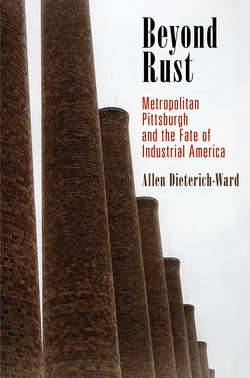Читать книгу Beyond Rust - Allen Dieterich-Ward - Страница 7
На сайте Литреса книга снята с продажи.
ОглавлениеPROLOGUE
This book is about a working landscape and its people, in which more than a century of hard use has eroded the distinction between the natural and the man-made. It began as an attempt to reconcile two competing visions from my childhood on the edge of metropolitan Pittsburgh. I often heard stories from my paternal grandparents about Egypt Valley, a nearby farming hamlet in the rolling hills of southeastern Ohio where they were raised. Their memories of bountiful harvests and social ties forged through the local church, school, and Grange Hall stood in sharp contrast to the area I knew from the 1980s, which had been largely abandoned by its inhabitants and deeply scarred by Consolidation Coal Company (Consol)’s enormous Egypt Valley Mine that opened there in the mid-1960s. This was now a landscape of cliff-like highwalls that rose more than a hundred feet above scrub-grass plains; of spoil banks and strip pits interspersed with the ghostly remnants of crumbling farmhouses, rusting machinery, and a hilltop cemetery around which former residents still gathered for yearly reunions.
I found out later that the fate of Egypt Valley was bound up with that of Pittsburgh, where Consol was headquartered, and that the city and its suburbs had their own landscapes to interpret. In fact, at the same time the mining company was rearranging Egypt Valley’s social and physical topography, some of its executives and largest shareholders were partnering with civic leaders to do the same thing downtown. In place of the messy, mixed-use, and increasingly shabby neighborhoods that had emerged over the previous century, the region’s economic and political elite envisioned a modern, rational, and productive environment that could compete with other regions. As in the countryside, the urban and suburban architecture, infrastructure, and, yes, the rivers, air and ground itself revealed the political struggles over community control, of changes in technology and transportation systems, of shifting national and international economics, and of the vagaries of natural processes. It was clear that, whether viewed from the center city looking out or from the countryside looking in, telling the story of metropolitan Pittsburgh required embracing the full panorama.
As the title Beyond Rust suggests, this book begins with the origins of metropolitan Pittsburgh as the world’s most important industrial center and ends by extending the story past hulking ruins of steel mills, mine tipples, and abandoned rail lines that formed the backdrop of my childhood. Working landscapes and the communities they nurture, after all, seldom simply disappear either in the face of environmental degradation or job losses, and the residents of metropolitan Pittsburgh have a particularly strong attachment to their region. I came across many heroes in my travels throughout this area, but even after dozens of oral histories and many years spent in the archives, I have found few clear-cut villains. This is not to say I agreed with all of the ideas espoused by the figures in the following pages, not by a long shot. But my personal and professional background has perhaps made me more sympathetic to a wider range of perspectives than might be the norm. In order to finance his dream of owning a farm, my father went to work as a coal miner, which provided the economic base on which I, an ardent environmentalist, went to college. For their part, my grandparents enjoyed a comfortable retirement after selling the coal rights to their property in the 1980s, which they were able to continue farming thanks to more stringent reclamation laws passed, in part, due to the public outcry over the Egypt Valley mine. The histories of urban renewal and suburban expansion require a similar level of nuance; for every project completed or thwarted, those on both sides were often full of good intentions.
